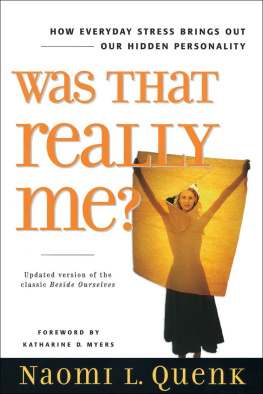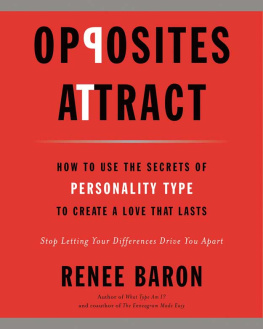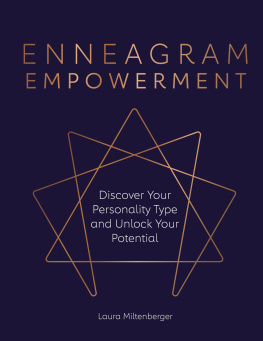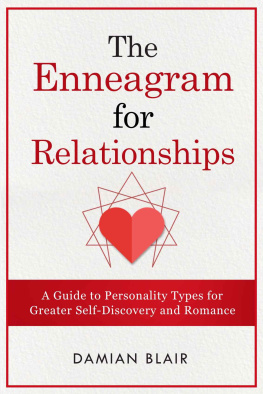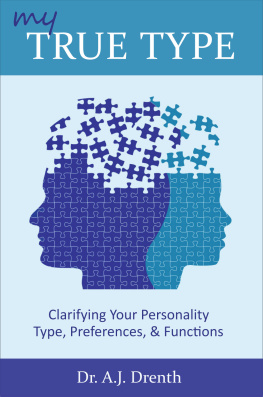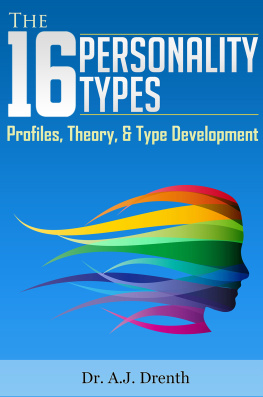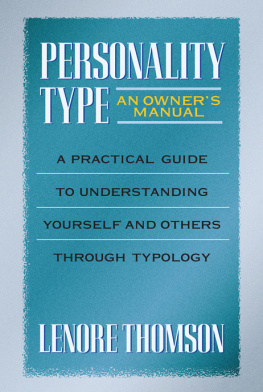Was THaT reaLLY Me?
Was THaT reaLLY Me?
HOW EVERYDAY STRESS BRINGS OUT
OUR HIDDEN PERSONALITY
NaomI L. Quenk

Published by Davies-Black Publishing, a division of CPP, Inc., 1055 Joaquin Road, 2nd Floor, Mountain View, CA 94043; 800-624-1765.
Special discounts on bulk quantities of Davies-Black books are available to corporations, professional associations, and other organizations. For details, contact the Director of Marketing and Sales at Davies-Black Publishing: 650-691-9123; fax 650-623-9271.
Copyright 2002 by Davies-Black Publishing, a division of CPP, Inc. All rights reserved. No part of this book may be reproduced, stored in a retrieval system, or transmitted in any form or media or by any means, electronic, mechanical, photocopying, recording, or otherwise, without the prior written permission of the publisher, except in the case of brief quotations embodied in critical articles or reviews.
Davies-Black and its colophon are registered trademarks of CPP, Inc. Myers-Briggs Type Indicator, MBTI, and Introduction to Type are trademarks or registered trademarks of the Myers-Briggs Type Indicator Trust in the United States and other countries.
The following publishers have generously given permission to use extended quotations from copyrighted works: From The Inferior Function, by Marie-Louise Von Franz. by Marie-Louise Von Franz. Reprinted by arrangement with Shambhala Publications, Inc., 300 Massachusetts Ave., Boston, MA 02115. From Jung, C. G., Collected Works, Volumes 6, 8, 9i, 11, 16, 18, and the Vision Seminars. Copyright 1976, 1960, 1959, 1969, 1954, 1976, 1976 by Princeton University Press. Reprinted by permission of Princeton University Press.
Visit the Davies-Black Publishing Web site at www.daviesblack.com .
Cover photograph: Tomek Kikora/Getty Images/The Image Bank
Printed in the United States of America.
11 10 09 08 10 9 8 7 6
Library of Congress Cataloging-in-Publication Data
Quenk, Naomi L.
Was that really me? : how everyday stress brings out our hidden personality / Naomi L. Quenk.1st ed.
p. cm.
Includes bibliographical references and index.
ISBN 978-0-89106-170-0 (pbk.)
1. Typology (Psychology). 2. Stress (Psychology). 3. Myers-Briggs Type Indicator. 4. Jung, C. G. (Carl Gustav), 18751961. I. Title.
BF698.3.Q47 2002
155.264dc21
2002023413
FIRST EDITION
First printing 2002
TO ALeX
Contents
Appendix A: Descriptions of the Sixteen
Personality Types
Appendix B: Selected Quotations from Jung
on His Typology
Foreword
I HAVE A VIVID RECOLLECTION OF N AOMI Q UENK at the podium before a gathering of Myers-Briggs Type Indicator (MBTI) practitioners at a conference in Philadelphia in October 1982. She was presenting for the first time her understanding of our hidden personality, which causes those unsettling moments when we are not ourselves. Naomi described the different patterns of uncharacteristic behavior that express each of the eight inferior functionsthe eight Jungian mental processes when they are used in a primitive and undeveloped manner. Members of the audience were intrigued as they recognized themselves in her type-related examples of these bewildering episodes. There was rueful laughter as we remembered behavior we had pushed aside in denial, shame, or guilt, or that we had readily blamed on others. It was heartening to be told that these experiences were part of being human; that if we recognized and faced them, they could serve as invaluable learning experiences for our personal growth. Naomi gave us specific steps through which we could integrate these moments and arrive at a more complete experience of our own positive selves.
Little did we realize at the time that this presentation was the beginning of a major and invaluable extension of the understanding and application of psychological type. Over the years, Naomi has led this exploration by gathering examples of inferior function experiences from workshops, psychotherapy clients, fellow practitioners, questionnaire data, and personal observations in everyday life. She used this information as the basis for Beside Ourselves: Our Hidden Personality in Everyday Life, published in 1993, which was followed in 1996 by a shorter work, In the Grip: Our Hidden Personality (revised in 2000 as In the Grip: Understanding Type, Stress, and the Inferior Function). And now, in 2002, we have this revision of the original book, which encompasses a wealth of new information and fresh insights into the depth and breadth of this aspect of Jungian psychology. As a result of these works, it is now customary for knowledgeable practitioners to include an introduction to the hidden personality in their workshops and consulting practices. Being in the grip, or beside oneself, has become common terminology among the many individuals who know their preference type.
Isabel Myers created the MBTI personality inventory to give individuals the benefits of knowing their Jungian preference type. Her focus was on each individuals potential for positive growth through type development. Over the years, knowledgeable type practitioners have introduced millions of people in diverse cultures to the MBTI instrument. Naomi Quenk has provided the next giant step in applying Jungs model of development in healthy personalities. That step is to understand, accept, and learn to handle our hidden personality responsibly. Naomi has given us a way to understand this part of ourselves as well as a practical guide for turning what appears to be negative into a positive awareness that enhances our growth and effectiveness. People typically find this to be a surprisingly freeing experience.
Isabel and Naomi shared a passionate belief that personality type and Jungs model of lifelong development provide a psychology that really works. Both focused their application of Jungian ideas on development in the healthy personality and worked hard to make these ideas meaningful and helpful in peoples lives. In the period of reflection preceding my writing of this foreword, I became even more aware that it is Katharine Briggs, Isabel Myers, and Naomi Quenk who have been the major forces in bringing Jungs ideas out into the wide, wide worldwhat I have called the democratization of Jungian ideas. Katharine studied Jungs work and saw its potential; Isabel took the core piece (what I think of as the doorway to the entire theory) and developed the MBTI instrument, which gave individuals the entry key to the entire theory. Naomi has completed the circle by pointing out the necessity of integrating the light and the dark that are intrinsic in Jungs theory. Valuable as the initial understanding of typology has been, it is this last addition that is essential if we are ever to break the cycle of violence that threatens to overwhelm our world today.
Katharine Downing Myers
Kennett Square, Pennsylvania
July 2002
Preface
I N THE NEARLY TEN YEARS SINCE Beside Ourselves, the first edition of this book, was published, I have learned a great deal more about how and when our hidden personality emerges in daily life. I now have a much greater appreciation of out-of-character episodes as essential to our general well-being as well as to our continuing growth and development. I continue to be awed by the overwhelming evidence that we are born with everything we need to become effective and complete human beings.
Next page
